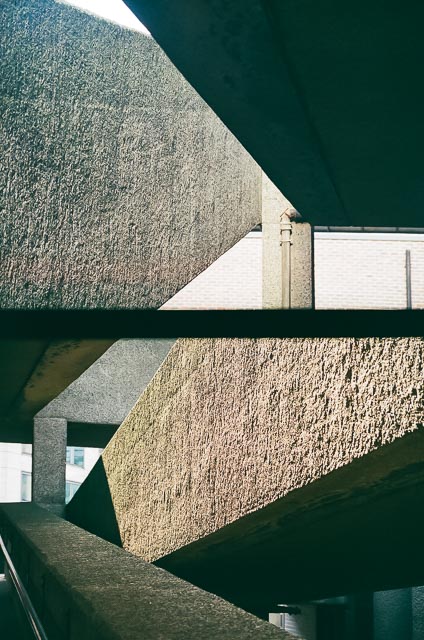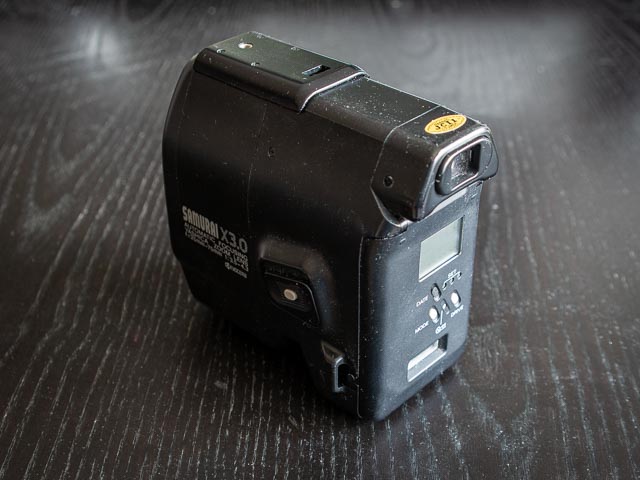Yashica Samurai X3.0

The Yashica Samurai series of camera is completely unique! They're really just standard 1980s auto-everything point and shoots, but they have 3 things that really set them apart from their competitors: unique 'camcorder' style design, the fact that they are real SLRs with a genuine through the lens viewfinder, and finally they are a half-frame cameras that create 72 18x24mm negatives on a 36 exposure role of 35mm film.
As far as know that makes the Yashica Samurai cameras one of only two series of purpose built half-frame SLRs, the other being the Olympus Pen F series of camera. The Samurai X3.0 was the first camera in the series. It was launched in 1987 and has, as the name might lead you to believe, a fixed 3x 25-75mm f/3.5-4.3 3x zoom lens for a full-frame 35mm equivalent field of view of approximately 35mm to 105mm. In 1988 the X.3.0 was joined by the larger x4.0 model with a 25-100mm f/3.8-4.8 4x zoom lens (equivalent to a 35-140mm field-of-view on a full-frame 35mm camera).
In 1989 these 2 models were replaced by the Samurai Z and Z-L which went back to a 3x zoom lens but in a more compact body. The Z-L model had exactly the same specification as the Z but in a mirror image body designed specifically for left handed people. In 1990 the final model was introduced as a little brother to the Z and Z-L models: the Z2 and Z2-L had a slightly simplified specification and a lower price.
You often hear people in the west say that the Samurai cameras were a big failure for Koycera (the company that bought the Yashica and Contax brands in 1982). But just because the Samurai cameras didn't sell well in the west doesn't mean there were a failure… the world doesn't stop at the eastern border of Europe or at the pcific ocean!. These cameras was a big hit in Asia, particularly in Japan where half-frame was always much more popular than in the west. It seems in Japan they like their cameras small and they also don't like buying film very often!
In use these cameras are a lot of fun to use, and of course being auto-absolutlely-everything they're also very easy to use. The only slight annoyance is that the flash is also part of the auto-everything system. It will fire or not as the camera decides. One of the buttons on the back of the camera puts the camera in a 'night time' mode which in practice can be use as a simple flash-off mode. But the camera resets to normal mode every time you turn the camera on, so you have to remember to set the camera to night-time mode every time you turn the camera on if you don't want flash.
One of the reason for the camcorder style body is that it allows the film to run vertically, meaning that unlike most half-frame cameras you get horizontal pictures by default.
Photographs taken with the Yashica Samurai X3.0
Half-frame gives you a lot of freedom to shoot almost as freely as you might with a digital camera with up to 72 shots per roll of film. But the real reason I got this camera was to experiment with creating in camera diptychs. The idea is this: you shoot frame 1 and then keep that image in your mind as you try to find a complimentary second image for frame 2. You do the same for frames 3 and 4, 5 and 6 and so on until you finish the film. You then ask your film processing company to treat the film in exactly the same way as the would a normal full-frame roll of film. (In practice you don't really have much choice about this part, as most film processors don't know how to treat half-frame film as half-frame film!) What you get back are prints with 2 images on each print.
The easiest way to do this is to simply shoot 2 images of the same subject but with different view points. But a bigger (and more fun!) challenge is to shot the second image some time later of a completely different, but complimentary, subject. You can see example of both approaches below.
These first 4 images were shot in my home city of Edinburgh.




The next 4 images were shot in and around the Barbican in London. Not sure why a few of the images in the middle of the roll shot some signs of light-leakage… but I quite like the look of this!




The final 4 images were all shot in and around London. These images were all shot by simply turning the camera upside-down for the second shot.




Links
- Yashica Samurai X3.0 manual on butkus.org

